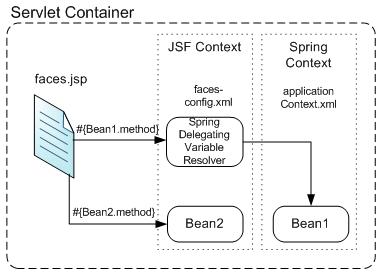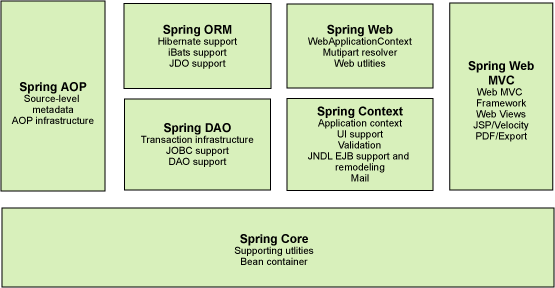|
Interview Resources
Java Interview Q&ARevision NotesInterview TipsLive Interviews
Certifications
OCAJOCPJPOCMJDOCPJWCDOCPJBCDOCPJWSDOCMJEA
Tutorials
ANTJDBCJSPServletsJSFHibernate
Jobs
Latest JobsSearch JobsPost a Job |
Java Positions in top Software Consulting Company in US
Multiple Java positions in top Software Consulting Company in US!
Spring Interview Questions
The below are a list of 40 most important Spring Interview Questions with answers. These questions are the most frequently asked Spring Interview Questions. If you feel any Spring question is not answered or if you have been asked a Spring question in the interview other than the ones listed below, please email your question to me (subbu@javaiq.net), I will answer your Spring question and include the Spring question to the below list of Spring Framework Interview Questions with your name as the contributor.
1.
What is IOC (or Dependency Injection)? The basic concept of the Inversion of Control pattern (also known as dependency injection) is that you do not create your objects but describe how they should be created. You don't directly connect your components and services together in code but describe which services are needed by which components in a configuration file. A container (in the case of the Spring framework, the IOC container) is then responsible for hooking it all up. 2. What are the different types of IOC (dependency injection) ? There are three types of dependency injection:
3. What are the benefits of IOC (Dependency Injection)? Benefits of IOC (Dependency Injection) are as follows:
4. What is Spring ? Spring is an open source framework created to address the complexity of enterprise application development. One of the chief advantages of the Spring framework is its layered architecture, which allows you to be selective about which of its components you use while also providing a cohesive framework for J2EE application development. 5. What are the advantages of Spring framework? The advantages of Spring are as follows:
6. What are features of Spring ?
7. How many modules are there in Spring? What are they?
Spring comprises of seven modules. They are..
8. What are the types of Dependency Injection Spring supports?>
9. What is Bean Factory ? A BeanFactory is like a factory class that contains a collection of beans. The BeanFactory holds Bean Definitions of multiple beans within itself and then instantiates the bean whenever asked for by clients.
10. What is Application Context? A bean factory is fine to simple applications, but to take advantage of the full power of the Spring framework, you may want to move up to Springs more advanced container, the application context. On the surface, an application context is same as a bean factory.Both load bean definitions, wire beans together, and dispense beans upon request. But it also provides:
11. What is the difference between Bean Factory and Application Context ? On the surface, an application context is same as a bean factory. But application context offers much more..
12. What are the common implementations of the Application Context ? The three commonly used implementation of 'Application Context' are
ApplicationContext context = new ClassPathXmlApplicationContext("bean.xml");
ApplicationContext context = new FileSystemXmlApplicationContext("bean.xml");
13. How is a typical spring implementation look like ? For a typical Spring Application we need the following files:
14. What is the typical Bean life cycle in Spring Bean Factory Container ? Bean life cycle in Spring Bean Factory Container is as follows:
15. What do you mean by Bean wiring ? The act of creating associations between application components (beans) within the Spring container is reffered to as Bean wiring.
16. What do you mean by Auto Wiring? The Spring container is able to autowire relationships between collaborating beans. This means that it is possible to automatically let Spring resolve collaborators (other beans) for your bean by inspecting the contents of the BeanFactory. The autowiring functionality has five modes.
17. What is DelegatingVariableResolver? Spring provides a custom JavaServer Faces VariableResolver implementation that extends the standard Java Server Faces managed beans mechanism which lets you use JSF and Spring together. This variable resolver is called as DelegatingVariableResolver 18. How to integrate Java Server Faces (JSF) with Spring? JSF and Spring do share some of the same features, most noticeably in the area of IOC services. By declaring JSF managed-beans in the faces-config.xml configuration file, you allow the FacesServlet to instantiate that bean at startup. Your JSF pages have access to these beans and all of their properties.We can integrate JSF and Spring in two ways:
<?xml version="1.0" encoding="UTF-8"?>
<!DOCTYPE beans PUBLIC "-//SPRING//DTD BEAN//EN"
"http://www.springframework.org/dtd/spring-beans.dtd">
<faces-config>
<application>
<variable-resolver>
org.springframework.web.jsf.DelegatingVariableResolver
</variable-resolver>
</application>
</faces-config>
 The DelegatingVariableResolver will first delegate value lookups to the default resolver of the underlying JSF implementation, and then to Spring's 'business context' WebApplicationContext. This allows one to easily inject dependencies into one's JSF-managed beans. ApplicationContext ctx = FacesContextUtils.getWebApplicationContext(FacesContext.getCurrentInstance()); 19. What is Java Server Faces (JSF) - Spring integration mechanism? Spring provides a custom JavaServer Faces VariableResolver implementation that extends the standard JavaServer Faces managed beans mechanism. When asked to resolve a variable name, the following algorithm is performed:
As a result of this algorithm, you can transparently use either JavaServer Faces or Spring facilities to create beans on demand. 20. What is Significance of JSF- Spring integration ? Spring - JSF integration is useful when an event handler wishes to explicitly invoke the bean factory to create beans on demand, such as a bean that encapsulates the business logic to be performed when a submit button is pressed. 21. How to integrate your Struts application with Spring? To integrate your Struts application with Spring, we have two options:
22. What are ORM’s Spring supports ? Spring supports the following ORM’s :
23. What are the ways to access Hibernate using Spring ? There are two approaches to Spring’s Hibernate integration:
24. How to integrate Spring and Hibernate using HibernateDaoSupport? Spring and Hibernate can integrate using Spring’s SessionFactory called LocalSessionFactory. The integration process is of 3 steps.
25. What are Bean scopes in Spring Framework ? The Spring Framework supports exactly five scopes (of which three are available only if you are using a web-aware ApplicationContext). The scopes supported are listed below:
26. What is AOP? Aspect-oriented programming, or AOP, is a programming technique that allows programmers to modularize crosscutting concerns, or behavior that cuts across the typical divisions of responsibility, such as logging and transaction management. The core construct of AOP is the aspect, which encapsulates behaviors affecting multiple classes into reusable modules. 27. How the AOP used in Spring? AOP is used in the Spring Framework:
To provide declarative enterprise services, especially as a replacement for EJB declarative services. The most important such service is declarative transaction management, which builds on the Spring Framework's transaction abstraction.To allow users to implement custom aspects, complementing their use of OOP with AOP.
28. What do you mean by Aspect ? A modularization of a concern that cuts across multiple objects. Transaction management is a good example of a crosscutting concern in J2EE applications. In Spring AOP, aspects are implemented using regular classes (the schema-based approach) or regular classes annotated with the @Aspect annotation (@AspectJ style). 29. What do you mean by JointPoint? A point during the execution of a program, such as the execution of a method or the handling of an exception. In Spring AOP, a join point always represents a method execution. 30. What do you mean by Advice? Action taken by an aspect at a particular join point. Different types of advice include "around," "before" and "after" advice. Many AOP frameworks, including Spring, model an advice as an interceptor, maintaining a chain of interceptors "around" the join point. 31. What are the types of Advice? Types of advice:
32. What are the types of the transaction management Spring supports ? Spring Framework supports:
33. What are the benefits of the Spring Framework transaction management ? The Spring Framework provides a consistent abstraction for transaction management that delivers the following benefits:
34. Why most users of the Spring Framework choose declarative transaction management ? Most users of the Spring Framework choose declarative transaction management because it is the option with the least impact on application code, and hence is most consistent with the ideals of a non-invasive lightweight container.
35. Explain the similarities and differences between EJB CMT and the Spring Framework's declarative transaction The basic approach is similar: it is possible to specify transaction behavior (or lack of it) down to individual method level. It is
37. When to use programmatic and declarative transaction management ? Programmatic transaction management is usually a good idea only if you have a small number of transactional operations. 38. Explain about the Spring DAO support ? The Data Access Object (DAO) support in Spring is aimed at making it easy to work with data access technologies like JDBC, Hibernate or JDO in a consistent way. This allows one to switch between the persistence technologies fairly easily and it also allows one to code without worrying about catching exceptions that are specific to each technology. 39. What are the exceptions thrown by the Spring DAO classes ?
Spring DAO classes throw exceptions which are subclasses of
40. What is SQLExceptionTranslator ? 41. What is Spring's JdbcTemplate ? Spring's JdbcTemplate is central class to interact with a database through JDBC. JdbcTemplate provides many convenience methods for doing things such as converting database data into primitives or objects, executing prepared and callable statements, and providing custom database error handling. JdbcTemplate template = new JdbcTemplate(myDataSource); 42. What is PreparedStatementCreator ? PreparedStatementCreator:
43. What is SQLProvider ? SQLProvider:
44. What is RowCallbackHandler ? The
45. What are the differences between EJB and Spring ? Spring and EJB feature comparison.
comments powered by Disqus |

